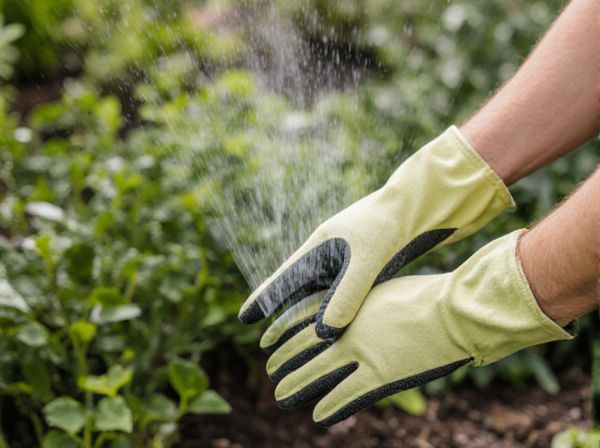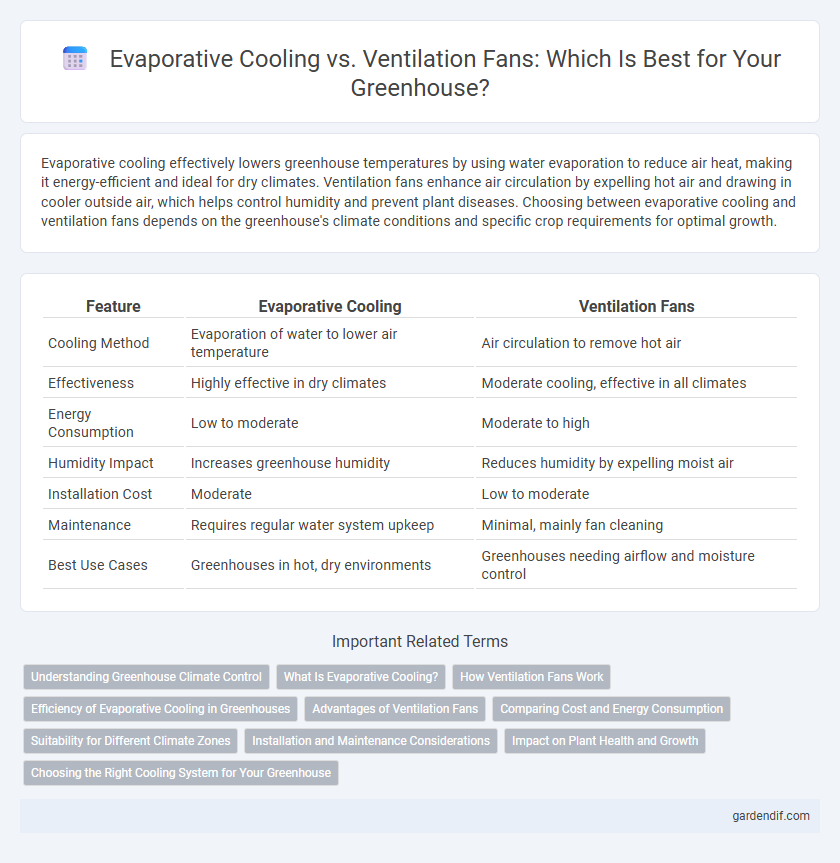
Evaporative Cooling vs Ventilation Fans Illustration
Evaporative cooling effectively lowers greenhouse temperatures by using water evaporation to reduce air heat, making it energy-efficient and ideal for dry climates. Ventilation fans enhance air circulation by expelling hot air and drawing in cooler outside air, which helps control humidity and prevent plant diseases. Choosing between evaporative cooling and ventilation fans depends on the greenhouse's climate conditions and specific crop requirements for optimal growth.
Table of Comparison
| Feature | Evaporative Cooling | Ventilation Fans |
|---|---|---|
| Cooling Method | Evaporation of water to lower air temperature | Air circulation to remove hot air |
| Effectiveness | Highly effective in dry climates | Moderate cooling, effective in all climates |
| Energy Consumption | Low to moderate | Moderate to high |
| Humidity Impact | Increases greenhouse humidity | Reduces humidity by expelling moist air |
| Installation Cost | Moderate | Low to moderate |
| Maintenance | Requires regular water system upkeep | Minimal, mainly fan cleaning |
| Best Use Cases | Greenhouses in hot, dry environments | Greenhouses needing airflow and moisture control |
Understanding Greenhouse Climate Control
Evaporative cooling effectively lowers greenhouse temperatures by increasing humidity and reducing air temperature through water evaporation, making it ideal for hot, dry climates. Ventilation fans enhance air circulation by expelling hot, humid air and bringing in fresh air, preventing heat buildup and promoting plant respiration. Combining both systems can optimize greenhouse climate control by balancing temperature, humidity, and airflow for improved plant growth and health.
What Is Evaporative Cooling?
Evaporative cooling in greenhouses uses a wet pad system where warm air passes through moistened pads, reducing air temperature through water evaporation, which increases humidity while lowering heat stress on plants. This method is energy-efficient and environmentally friendly, consuming significantly less electricity compared to traditional ventilation fans that mechanically circulate air without cooling. Properly implemented evaporative cooling enhances plant growth and yield by maintaining optimal temperature and humidity levels inside the greenhouse environment.
How Ventilation Fans Work
Ventilation fans in greenhouses operate by drawing out warm, stale air and replacing it with cooler, fresh air from outside, thereby regulating temperature and humidity levels effectively. These fans create continuous air movement, which enhances transpiration and prevents the buildup of heat and moisture that can lead to plant stress or disease. Unlike evaporative cooling systems that rely on water evaporation to lower air temperature, ventilation fans primarily focus on air exchange to maintain an optimal growing environment.
Efficiency of Evaporative Cooling in Greenhouses
Evaporative cooling systems enhance greenhouse climates by reducing air temperatures more efficiently than traditional ventilation fans, especially in dry conditions where they can lower temperatures by up to 15degF. This method uses water evaporation to cool incoming air, maintaining optimal humidity levels and promoting healthier plant growth while minimizing energy consumption. Compared to ventilation fans, evaporative cooling systems provide superior temperature control, improving crop yields and reducing heat stress in controlled environments.
Advantages of Ventilation Fans
Ventilation fans provide precise control over airflow and temperature, improving plant health by reducing humidity and preventing fungal diseases in greenhouses. They offer energy efficiency by circulating air evenly, which helps maintain consistent climate conditions without excessive power consumption. This targeted airflow also enhances CO2 distribution, boosting photosynthesis and overall crop yield.
Comparing Cost and Energy Consumption
Evaporative cooling systems generally have lower initial installation costs compared to ventilation fans but may incur higher maintenance expenses due to water usage and filter replacements. Energy consumption for evaporative coolers is significantly lower, often reducing electricity use by up to 70% compared to traditional ventilation fans that rely solely on motor-driven airflow. Choosing between the two depends on balancing upfront investment with ongoing operational efficiency and climate-specific water availability.
Suitability for Different Climate Zones
Evaporative cooling is highly effective in hot, dry climates where low humidity allows for maximum temperature reduction through water evaporation, making it ideal for arid regions like Southwest United States or parts of Australia. Ventilation fans excel in humid climates by promoting air circulation and reducing heat buildup without adding moisture, suitable for tropical zones such as Southeast Asia or Florida. Selecting the right system depends on local climate characteristics to optimize greenhouse temperature control and plant growth conditions.
Installation and Maintenance Considerations
Evaporative cooling systems in greenhouses require installation of water supply lines and pads, demanding regular maintenance to prevent mineral buildup and ensure efficient cooling. Ventilation fans involve electrical wiring and mounting structures, with maintenance focusing on cleaning fan blades and checking motor function for optimal airflow. Proper installation and upkeep of both systems are essential to maintain temperature control and promote healthy plant growth.
Impact on Plant Health and Growth
Evaporative cooling systems enhance plant health by maintaining optimal humidity and temperature levels, reducing heat stress, and improving photosynthesis efficiency, which promotes faster growth and higher yields. Ventilation fans primarily regulate air circulation, preventing the buildup of harmful gases and reducing disease risk, but they do not actively lower temperatures or humidity as effectively as evaporative cooling. Combining both methods can create a balanced environment, optimizing plant respiration and transpiration processes essential for robust development.
Choosing the Right Cooling System for Your Greenhouse
Evaporative cooling systems lower greenhouse temperatures by using moisture evaporation, effectively reducing heat while increasing humidity, ideal for dry climates. Ventilation fans enhance air circulation, expelling hot air and introducing fresh air to manage temperature and humidity, suitable for various environmental conditions. Selecting the right cooling system depends on your greenhouse's size, climate, and plant requirements to optimize growth and energy efficiency.
Evaporative Cooling vs Ventilation Fans Infographic

 gardendif.com
gardendif.com